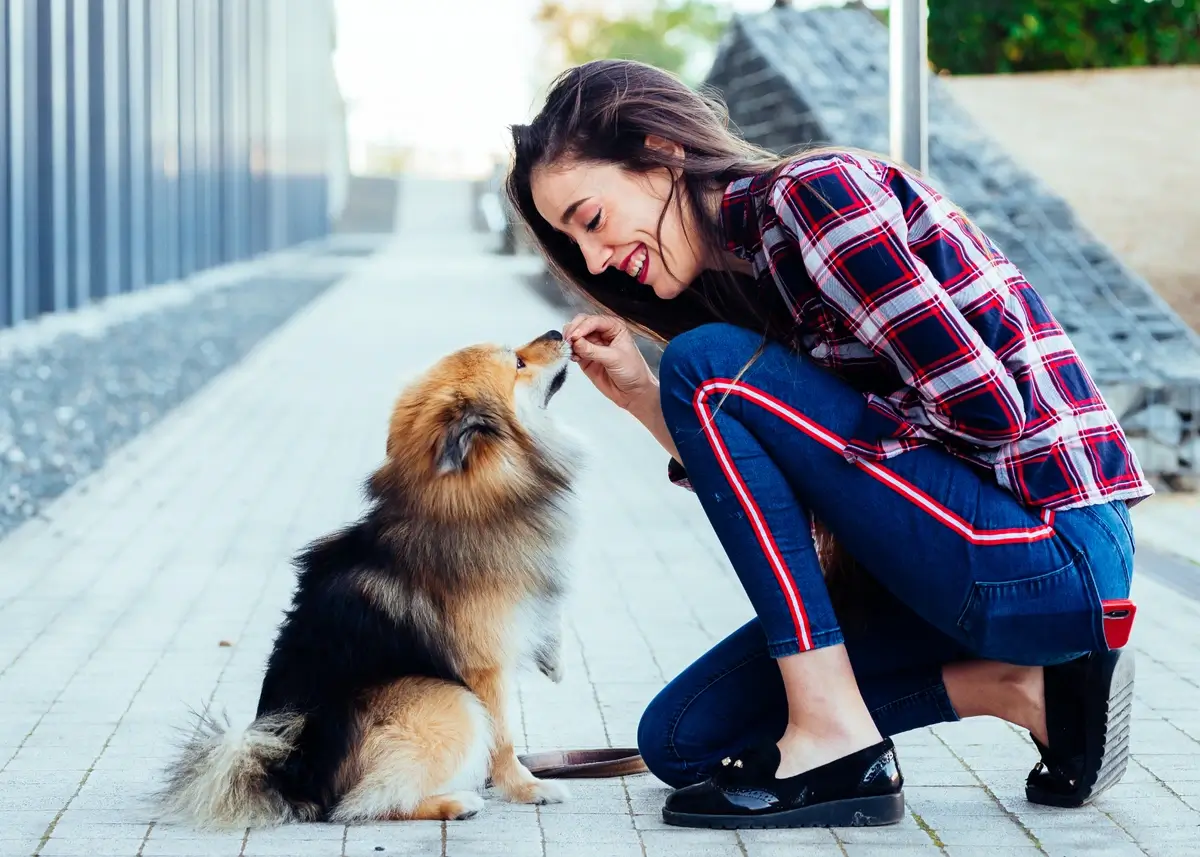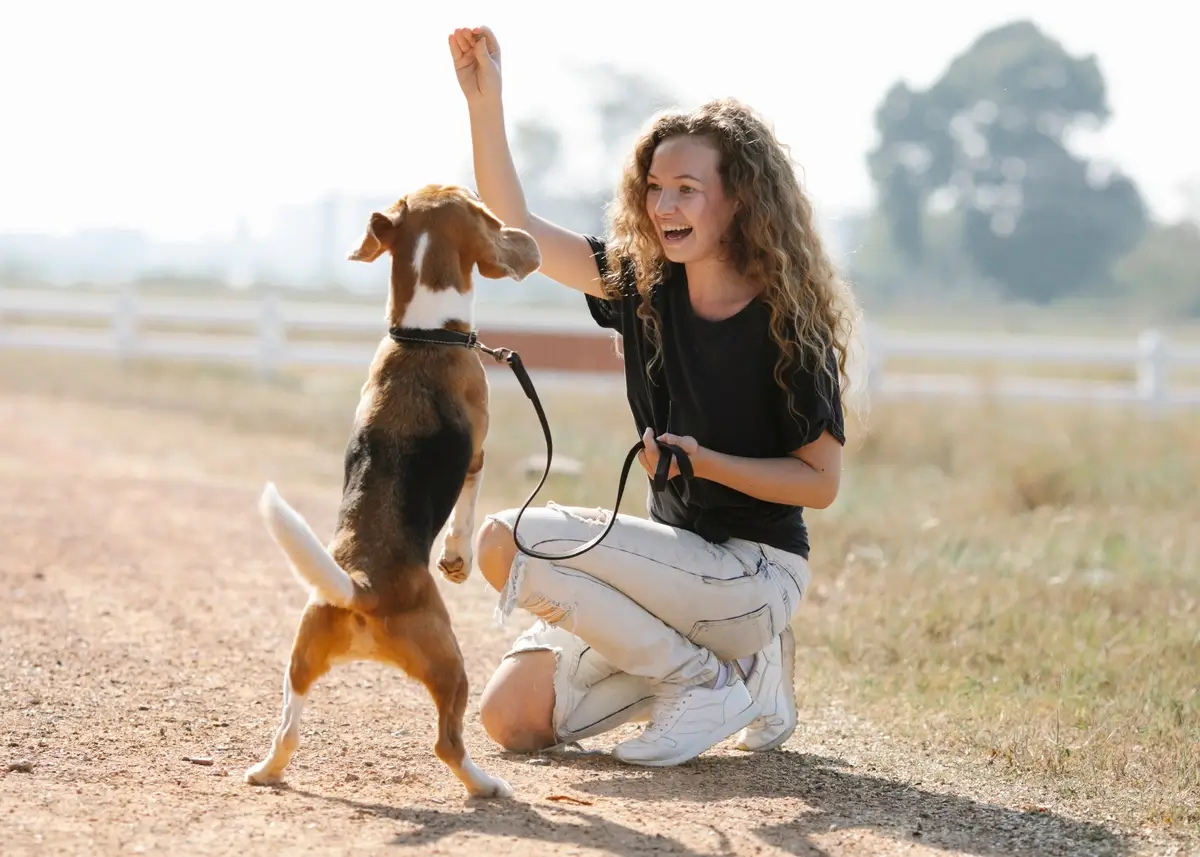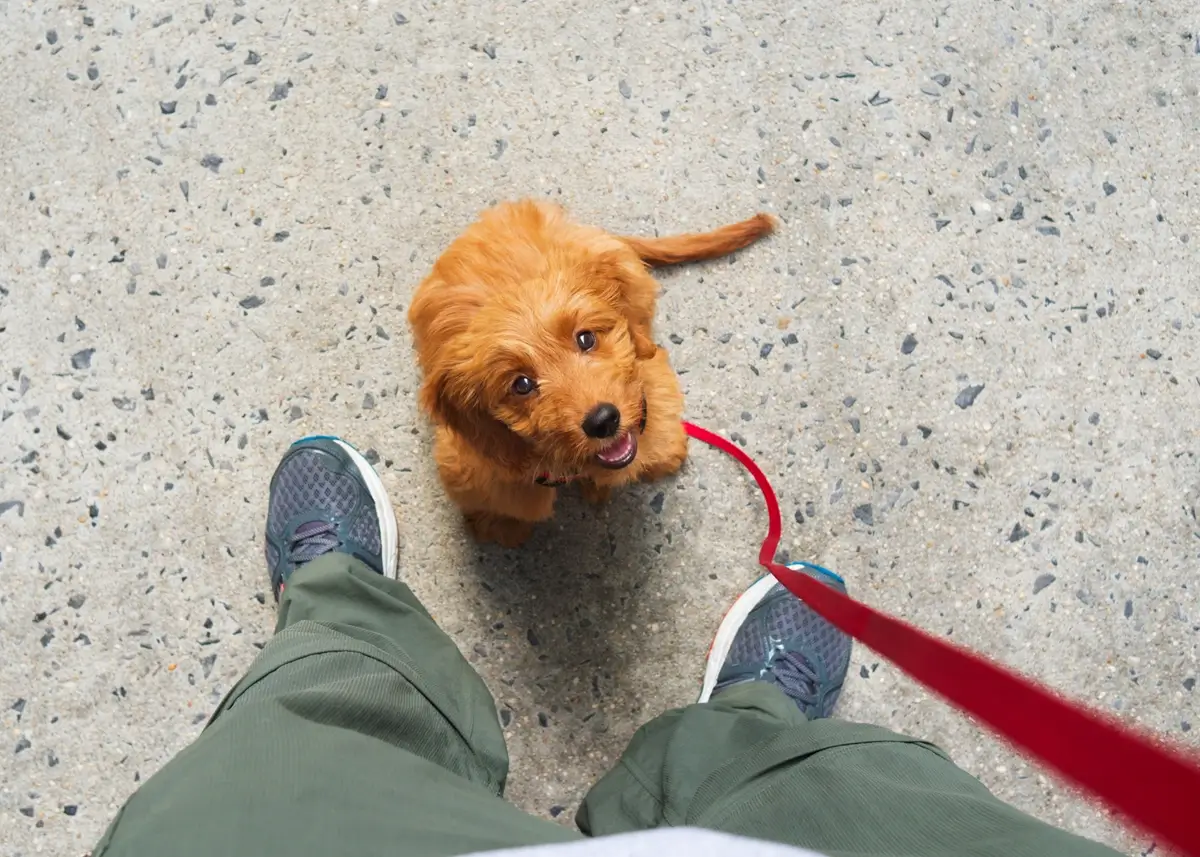Society loves a well-behaved dog. No one wants an unruly dog lunging at them. When your puppy is socialized properly and trained with basic commands, it means they can be around other dogs as well, walk nicely on a leash, and come when called to prevent them from getting into trouble or danger.
Let’s face it – living with a new puppy is very similar to living with a human toddler! They’re exuberant, aren’t afraid to explore their surroundings, and can be loads of fun (when they’re not getting into trouble, that is). They also both need lots of guidance from adults who love them and want to see them succeed in life. As your owner, they look to you to lead the pack – and training helps you stay at the top so your dog doesn’t take over the show while teaching them boundaries.
Teaching your puppy commands helps him know what to expect. Learn why teaching 6 basic puppy commands is vital to your dog’s happiness and how to have successful puppy commands training sessions.
Why Do I Need to Train My Puppy?
It’s not a good practice to just assume your puppy will pick up on what you’d like for her to do. Here are some reasons why you should learn how to teach puppy commands.
Accelerates your bond
Your puppy gives you unconditional love, so you should share yours as well. The more time you spend with your puppy in a positive environment by teaching basic puppy commands, the more secure they will feel and ultimately will be better behaved by wanting to please you.
Prevents undesirable behaviors
Training your puppy results in less puppy separation anxiety, which could lead to destruction and undesirable behavior. Since training is a form of mental and physical exercise, a tired puppy will be easier to leave and will be more secure knowing you will return.
Helps channel their energy
Training your puppy is just one of the ways to exercise your dog because they can think they are playing. The more training can be a structured game, the more fun they will have and be more likely to do what you ask of them.
Gives mental stimulation opportunities
Training provides mental stimulation for your dog. They will activate different parts of their brains to remember commands, and learning new basic puppy training commands will keep them sharp.
Ensures your puppy is a good canine citizen
You want your puppy to be able to interact well with its environment. Learning basic puppy commands will ensure your dog is a delightful companion in any situation. For more information on getting your puppy ready to navigate the real world, explore the American Kennel Club’s Canine Good Citizen™ (CGC) Program, a 10-skills certification teaching good manners and support for their humans.
How to Teach Basic Puppy Commands
New puppy owners will love any tips for puppy obedience training they can find! Here are a few tools to help you teach basic puppy commands.
Use positive reinforcement
Positive reinforcement is when you reward a puppy in an exciting way after they do a desired behavior, therefore making him more likely to perform the behavior you want from them again. When you give them the reward, you can say, “Yes!” or “Good boy/girl!” in a very happy, upbeat tone to show your puppy you are pleased with his behavior.
Rewards
Puppies will start out loving just about any reward you give them! No matter what the reward, you need to make sure it’s special and of high value to your puppy. They’re more likely to work for a fun reward rather than one that they are bored with or don’t care for. Rotate your rewards so your puppy doesn’t get bored of the same treat. Use real meat but in tiny pieces. You can phase out the treat once they have the command down, but give them one every now and then to stay fresh with skills and keep up the interest.
Here are some great reward ideas for a job well done:
- Liver
- Salmon
- Chicken
- Playtime
- Deli meat
- Belly rubs
- A fun game
- A favorite toy
- A dance party
- Pieces of kibble
- Blowing bubbles
- A pat on the head
- A scratch behind the ears
Keep the session short and sweet
Learning how to teach your puppy basic commands is about repetition and frequency, not the length of the session. You can start with short sessions of 5-10 minutes in the beginning. You may even find yourself working up to 30 minutes – if your puppy is having a blast and you have the time, why stop? Make training a routine a few times a day.
Have patience
Easier said than done. Rome wasn’t built in a day. Slow and steady wins the race. You can apply several proverbs to training a puppy! It will take time for the best results, and you need to be committed to having success – but that’s not always so easy.
Take deep breaths and a moment to put yourself in the right headspace. If you are frustrated, you are more likely to lose your temper. You can always try again if the session is a total bust. Keep at the forefront of your mind that you are so fortunate to be a pawrent and have this 4-legged furball in your life, even though it’s so hard to remember that in the moment (or even if you have to say it through clenched teeth sometimes).
How Not to Train Your Puppy
Never hit a puppy out of frustration, whether someone bops a puppy on the nose with a rolled-up newspaper, uses a shock collar for not doing the command right away, or if your puppy has a potty accident. Avoid yelling because many breeds are sensitive and will learn to fear you instead of pleasing you.
Physical punishment for dogs does not work and can even be against the law charged as animal cruelty in the US. Setting this terrible precedent will derail your entire training efforts by causing future damage and psychological problems. Your puppy is counting on you to provide a safe, loving environment to form a strong bond, not learn to recoil from you
6 Basic Puppy Commands
When you’re wondering where to start in how to teach a puppy 6 basic commands, you’ll want to make sure your puppy knows its name and how to get its attention.
Teach your puppy its own name
Start with treats! Get down on your dog’s level. Hold a treat in front of you and say your dog’s name. Each time your puppy pays attention and responds to her name, give her a treat. Do this for a bit and then take a small break. Move locations and try again until they catch on, which they will when there’s a tasty, enticing morsel.
Teach your puppy to pay attention to you
Now you can teach your dog to pay attention to you in the same manner by teaching the command Look. You want to make sure your dog is focused on you during training sessions and reward them for paying attention. Look helps form the basis of teaching those basic puppy commands. You’ll also get to know which treats your puppy prefers – might as well try them all.
Once your puppy responds reliably to both her name and Look, begin with the most essential basic puppy commands! And remember, always end on a positive note, and don’t move too quickly in between commands so you give your puppy a chance to learn each one.
Sit
The Sit command is an excellent basic puppy command to begin your training journey. Learning an easy command will make you feel accomplished and will allow your puppy to earn easy, quick praise, meaning you will gain lots of traction in a short amount of time.
Start with a Look command and hold a treat in front of your puppy’s nose. Raise it ever so slightly right above your puppy’s nose. Your puppy will naturally lower his bum to a seated position to try to reach the treat just out of reach. Once your puppy holds the position, quickly say Sit and reward your puppy with a treat and an ear rub. If you’d like, a big reward after a treat would be some fun playtime with you.
You can practice the Sit command several times throughout the day. It’s a great one to practice before doing another activity, like eating or putting on a leash for a walk.
Down
Teaching your dog the Down command is a natural segue from Sit. With your dog in the Sit position, take another treat, place it in front of his nose, and slowly lower it just out of reach until the treat is near the floor. Once your puppy’s elbows are resting on the floor, you can then move the treat away from their nose and close to the ground so your puppy stretches out to get it.
Say Down once they hold the position and then give the reward with lots of praise.
Come
The Come command is so powerful that it could save your dog’s life! The come command is associated with the term Recall, when your dog obeys right away and returns to you. You’ll want to use recall when your dog is heading toward traffic, wandering off, getting a bit too curious about where he shouldn’t be, or avoiding a fight at the dog park.
To begin to teach this vital recall puppy command, say your dog’s name and the command Come. They don’t even have to do anything – go ahead and give them a treat if they look at you and pay attention. We want to ensure your puppy associates this command with fantastic rewards!
For the next step, you want to drop or toss treats near you when your puppy is distracted. Say Come and his name. When he comes and gets the treat, say his name again and give another treat! You can start seeing the pattern, right? Treat, name, Come, treat.
Start gradually tossing the treats further away. Directly after he eats the treat, say his name and get him to turn and look at you, offering another treat from where you are. From there, make it fun for your puppy by backing away a few steps. Your puppy will run to you and learn that Come means he’ll have to go to where you are.
Not to say that you will go easy on the other commands, but please pay extra attention to the Come command. Once your puppy can obey reliably with just you, then you can add distractions, such as a person walking by, another friendly dog they’re tempted to play with, waterfowl, enticing toys, etc. to further solidify their obedience.
Stay
The Stay command is also a great safety tool when teaching a puppy basic commands. It prevents your puppy from running around and knowing where she is after you place her there. It takes a lot of self-control for a puppy to master the Stay command, so make sure to practice, practice, practice!
Start by asking your puppy to Sit. Back away slowly. Hold up your hand, palm facing your puppy, and say Stay. If they start to come toward you, say No and place them back in a Sit.
Once your dog reliably stays in the Sit position, you can either approach your puppy with a treat and praise or work on the Come command. Practice Stay frequently, especially when taking it up a notch by introducing distractions.
Leave it
You’ll find yourself so happy you taught your puppy this command because it’s inevitable he will grab something he’s not supposed to, especially during their puppy teething phase. When you teach your puppy Leave It, he will ignore whatever he’s about to get into so you can redirect his attention to a more positive activity.
Place a treat on the ground and cover it with your hand. Use the Look command so your dog pays attention to you rather than what’s under your hand, and reward your puppy with another treat you have hidden behind your back.
Next, repeat the process, saying Leave it and give a hidden reward as soon as your dog stops paying attention to the treat under your hand.
With practice, your puppy will learn that the hidden treat in your hand is worth more than the treat under your hand. You can then move on to a favorite toy, a ball, or other high-value items by rewarding them with a hidden treat.
Related commands to Leave it include Take it and Drop it, which you may want to explore as a natural next step when your puppy catches on to Leave it.
Heel
It’s a great idea to get your puppy used to walking on a loose leash nicely, even if you are not going on long walks every day. Introducing leash walking is an easy way to control where they go and teach boundaries. Focus on training walks with no real destination rather than trying to walk around the block when starting.
Teaching the Heel command means they aren’t tugging on a leash, dragging and pulling you in a direction you don’t want to go, or lunging at people or other dogs walking by. The Look command is a great way to start Heel to get your puppy used to looking up at you.
Ask your puppy to Sit before putting on her leash. Start by walking around, luring your puppy with a delicious treat. She will naturally want to follow you around, so be sure to give lots of treats when she comes toward you. The goal here is to associate moving while paying attention to you with a treat.
Once your puppy reliably looks at you, start moving forward slowly with your puppy on your left side. Stop frequently and place your puppy in a Sit. When you begin to walk, that’s when you want to say Heel and reward them while they’re walking so your puppy associates the beginning movement as the Heel command.
Ready for more training fun?
If your puppy is doing great with training, why not continue with some really fun dog tricks to impress your friends? Everyone loves a puppy with a party trick!
Teach a Pawrade Puppy Basic Commands
We can’t wait to help you select and purchase your new four-legged furry friend! We’re here for you at every step of the process. Search our puppies for sale to find that cute puppy to train!





